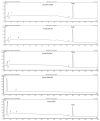The Phytochemical Screening and Biological Properties of Brassica napus L. var. napobrassica (Rutabaga) Seeds
- PMID: 37687079
- PMCID: PMC10488400
- DOI: 10.3390/molecules28176250
The Phytochemical Screening and Biological Properties of Brassica napus L. var. napobrassica (Rutabaga) Seeds
Abstract
Rutabaga, also known as swede and scientifically classified as Brassica napus napobrassica, is a biennial edible root vegetable that belongs to the Brassica genus and is widely cultivated in North Europe and North America. The present study highlights both the phytochemical profile and the in vitro biological properties of rutabaga seed extracts obtained through maceration using solvents of increasing polarity, namely, cyclohexane (CYHA), dichloromethane (DCM), ethyl acetate (EtOAc), methanol (MeOH), and water (H2O). HPLC-DAD was used to identify and quantify phenolic compounds, while volatile compounds were detected using GC-MS. The in vitro antioxidant capacity of the rutabaga seed extracts was evaluated through DPPH free radical scavenging activity. The in vitro anti-inflammatory activity (15-lipoxygenase (15-LOX) enzyme) was determined spectrophotometrically at the same concentration. Additionally, the cytotoxicity of the seed extracts was evaluated against human colon adenocarcinoma cells (Caco-2) and human embryonic kidney cells (HEK-293) using the MTT assay. The rutabaga seed extracts obtained from EtOAc, MeOH, and H2O were particularly rich in reducing sugars, ranging from 189.87 to 473.75 mg/g DW. The MeOH extract displayed the highest concentration of both sugars and polyphenols. Phytochemically, the HPLC-DAD analysis revealed the presence of four phenolic compounds in the tested extracts, including (±) synephrine, gallic acid, p-coumaric acid, and trans-ferulic acid, newly discovered in rutabaga organs. Moreover, a total of ten volatile compounds were identified through GC-MS analysis, both before and after derivatization. At a concentration of 50 µg/mL, the methanol extract exhibited high antioxidant activity with 52.95% inhibition, while CYHA, DCM, and EtOAc exhibited moderate anti-15-LOX activity with less than 30% inhibition. Except for DCM and aqueous extracts, rutabaga seeds did not exhibit any anti-proliferative potential against Caco-2 cell lines. Interestingly, no cytotoxicity was registered for any of the seed extracts against the normal cell line HEK-293. Overall, the obtained data highlight the potential utilization of rutabaga seeds as a source of bioactive compounds in various fields, including pharmaceuticals, nutraceuticals, and functional foods.
Keywords: GC-MS; HPLC-DAD; chemical profile; in vitro bioactivity; maceration; rutabaga seeds.
Conflict of interest statement
The authors declare no conflict of interest.
Figures







Similar articles
-
Rutabaga (Brassica napus L. var. napobrassica) seeds, roots, and sprouts: a novel kind of food with antioxidant properties and proapoptotic potential in Hep G2 hepatoma cell line.J Med Food. 2013 Aug;16(8):749-59. doi: 10.1089/jmf.2012.0250. J Med Food. 2013. PMID: 23957358
-
Chemical Characterization and Antioxidant, Antibacterial, Antiacetylcholinesterase and Antiproliferation Properties of Salvia fruticosa Miller Extracts.Molecules. 2023 Mar 7;28(6):2429. doi: 10.3390/molecules28062429. Molecules. 2023. PMID: 36985401 Free PMC article.
-
African mustard (Brassica tournefortii) as source of nutrients and nutraceuticals properties.J Food Sci. 2020 Jun;85(6):1856-1871. doi: 10.1111/1750-3841.15157. Epub 2020 May 31. J Food Sci. 2020. PMID: 32476145
-
Which Extraction Solvents and Methods Are More Effective in Terms of Chemical Composition and Biological Activity of Alceafasciculiflora from Turkey?Molecules. 2022 Aug 6;27(15):5011. doi: 10.3390/molecules27155011. Molecules. 2022. PMID: 35956963 Free PMC article. Review.
-
Phytochemical investigation, in vitro and in vivo antioxidant properties of aqueous and organic extracts of toxic plant: Atractylis gummifera L.J Ethnopharmacol. 2020 May 10;253:112640. doi: 10.1016/j.jep.2020.112640. Epub 2020 Feb 3. J Ethnopharmacol. 2020. PMID: 32027998 Review.
Cited by
-
Chemical Composition and In Vitro Bioactivities of Extracts from Cones of P. halepensis, P. brutia, and P. pinea: Insights into Pharmaceutical and Cosmetic Potential.Plants (Basel). 2024 Jun 29;13(13):1802. doi: 10.3390/plants13131802. Plants (Basel). 2024. PMID: 38999642 Free PMC article.
-
Bacillus megaterium: Evaluation of Chemical Nature of Metabolites and Their Antioxidant and Agronomics Properties.Int J Mol Sci. 2024 Mar 12;25(6):3235. doi: 10.3390/ijms25063235. Int J Mol Sci. 2024. PMID: 38542209 Free PMC article.
References
MeSH terms
Substances
LinkOut - more resources
Full Text Sources
Miscellaneous

